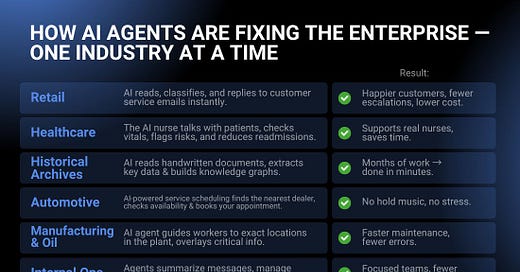The Enterprise Is Broken (And AI Agents Are the Fix)
The Mess We Built Ourselves Into
We’ve hit a wall.
No, scratch that. We’ve slammed into it at full speed, arms flailing, juggling 17 Slack threads, 38 unread emails, three dashboards that don’t talk to each other, and a meeting to prep for… about the last meeting.
If you’re a CEO, CTO, or any sort of decision-maker, you know exactly what I’m talking about.
The enterprise is broken, and we’re drowning in systems that were never designed to talk to each other or help us make decisions.
Not because people are lazy or tech is bad. It’s broken because it’s fragmented.
Well… it was, until AI agents arrived.
A New Solution to New Problems
I’m not talking about AI that “helps you write emails.”
I’m talking about AI that works with you and for you. In your stack, across your workflows.
We’ve built AI agents that act like coworkers: they read, understand, summarize, respond, schedule, tag, and alert, without pinging you every five minutes.
Here’s what that looks like across industries.
Agents in the Wild: What AI is Already Fixing
Retail: 13,000 Emails? No Problem.
We helped a retail company handle 13,000 customer service emails per day.
90% were repetitive: “Where’s my order?”, “How do I return this?” etc.
We built an agent that:
Reads incoming emails.
Classifies and responds instantly.
Escalates only the edge cases to humans.
Result: Less overhead, faster responses, happier customers.
Healthcare: The AI Nurse
Hospitals are facing nurse shortages – this has been the problem for decades.
So we built an agent that:
Talks to patients via audio (yes, like a real nurse).
Checks vitals, monitors meds, and flags risks.
Follows up post-discharge to reduce readmission.
BTW, it's trained to pass real certification exams like human staff.
All we needed was speech-to-text + Gemini + decades of nursing data.
Result: Not replacing real nurses, but making their work easier and faster.
History Meets the Future: AI-powered Library
The Abraham Lincoln Library used to rely on 10 historians to transcribe documents, but it was still too long and complicated.
We replaced the manual work with an AI agent that:
Reads and transcribes handwritten docs.
Extracts names, dates, and topics.
Builds a searchable knowledge graph.
Outcome: Months of work reduced to minutes.
Automotive: Smarter Service with No Wait Time
Luxury car owners hate calling dealerships for a reason: scheduling a service appointment can be… stressful. The same goes for the customer service: too many calls, angry clients, burnout.
So we built an agent that:
Integrates with Google Maps and calendars.
Finds nearest dealership and availability.
Books your appointment based on your model and maintenance schedule.
Result: No call center. No wait. Just done.
Manufacturing & Oil: No More Getting Lost in the Plant
In oil & gas, plant maps are chaos, so we digitized the infrastructure to bring in clarity and order.
Our agent now:
Shows workers where to find a valve.
Guides them there via digital twin overlays.
Speeds up maintenance and reduces errors.
Result: No more time-consuming searches, just quick insights and quick solutions.
Zazmic's Internal Ops: Meet Our Own Agents
We use what we sell.
At Zazmic:
I have a personal AI that summarizes my emails and Google Chat every morning and tells me what actually matters.
Our HR agent handles onboarding, reviews, and contractor lifecycles for 600+ people.
We’ve automated RFPs, contract prep, and compliance docs.
Honestly? I don’t remember how we functioned before.
So What Now?
You can keep duct-taping dashboards.
Or you can start working with agents that actually work for you.
Whether it’s about automating service ops, forecasting inventory, fixing broken internal workflows, or finally consolidating knowledge, you don’t need another platform.
You need a smarter teammate, and we’ll show you how to build one.
Join our next AI workshop.
We walk through real POCs, show how AI applies to your industry, and help you go from scattered chaos to smart automation.
It’s free, highly insightful, and a little mind-blowing.
See you next time,
Yann




